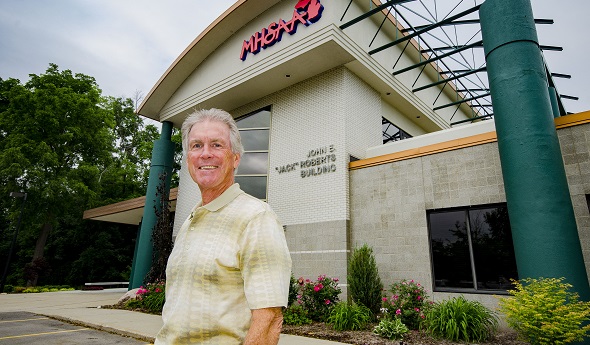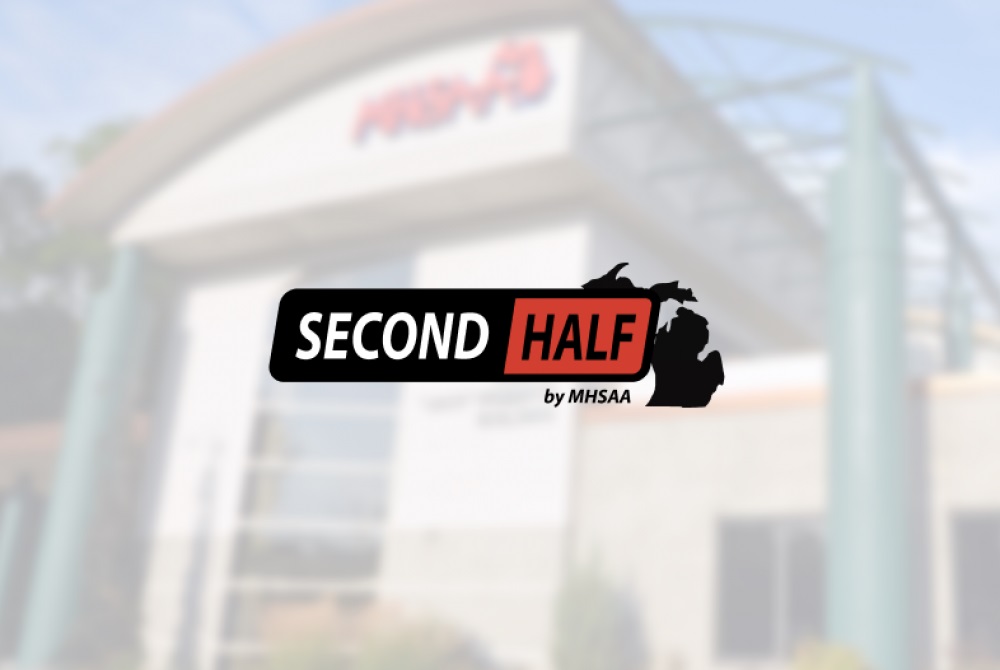
MHSAA Building Named for Retiring Director
By
Geoff Kimmerly
MHSAA.com senior editor
June 26, 2018
To recognize 32 years of leadership and service to Michigan educational athletics, the MHSAA Representative Council has named its home office in East Lansing after longtime Executive Director John E. “Jack” Roberts, who will retire in August.
The dedication of the “John E. ‘Jack’ Roberts Building” was approved by the Council during its Spring Meeting, May 6-7 in Gaylord, with the fabrication and assembly of the lettering financed by several private donations.
The building, located at 1661 Ramblewood Drive in East Lansing, opened as headquarters for the Association on January 3, 1997. The 20,000-square-foot, two-story facility houses MHSAA staff offices and resources including a publications library, plus multiple conference spaces frequently used to host meetings not only for MHSAA business but by leagues, coaches associations and other groups joining people from across the state.
Roberts, who announced his retirement April 24, will conclude his tenure next month as the second-longest serving full-time executive director during the MHSAA’s 94-year history. He is the fourth person to serve that leadership role full time, following Charles E. Forsythe (1931-42, 1945-68), Allen W. Bush (1968-78) and Vern L. Norris (1978-86). Roberts currently is also the nation’s longest-serving executive director of a state high school athletic association.
“This is an entirely unexpected honor,” Roberts said, “and while I am proud of the building, I’m even prouder of the people who have worked in it.”
The metallic lettering announcing the building’s name was designed by Image360 of Brighton and placed on the façade at the center of the building below the large MHSAA logo facing the property’s parking lot.
John Peckham, then of Martin Property Development of East Lansing, oversaw the original Ramblewood project. The building was designed by Keystone Design and built by Granger Construction.
Prior to the move to its current offices, the MHSAA was housed at 1019 Trowbridge Road in East Lansing from 1976-96. The MHSAA moved to the Trowbridge location from a downtown Lansing office it had leased since 1958.
With his retirement upcoming, Roberts also will leave the National Federation of State High School Associations (NFHS) Board of Directors later this week during the Summer Meeting in Chicago. He also will conclude an extended term as board chairperson of the NFHS Network. Roberts previously served as an assistant director for the National Federation from 1973-80 and came to the MHSAA in the fall of 1986 from the Fellowship of Christian Athletes, which he served as executive vice president.
Assistant Director Mark Uyl was chosen by the Representative Council in May to succeed Roberts as MHSAA executive director.
The MHSAA is a private, not-for-profit corporation of voluntary membership by more than 1,500 public and private senior high schools and junior high/middle schools which exists to develop common rules for athletic eligibility and competition. No government funds or tax dollars support the MHSAA, which was the first such association nationally to not accept membership dues or tournament entry fees from schools. Member schools which enforce these rules are permitted to participate in MHSAA tournaments, which attract more than 1.4 million spectators each year.

MHSAA Survey Shows Continued Lower Rate of Schools Charging Participation Fees During 2021-22
By
Geoff Kimmerly
MHSAA.com senior editor
July 28, 2022
Although participation in high school sports rebounded significantly at Michigan High School Athletic Association schools during the 2021-22 school year, the percentage of member schools charging participation fees remained near its lowest of the last two decades after a major reduction during 2020-21 when fall and winter activities were affected by COVID-19.
Only 40 percent of MHSAA member schools charged participation fees during the 2021-22 school year, following 41 percent using them during 2020-21 – after 48 percent of member schools reported charging them during the 2019-20 school year, when athletics operated normally until the pandemic resulted in a shutdown that March. The dips into the low 40s were the lowest percentages of schools assessing fees since the 2006-07 school year.
The MHSAA participation fee survey has measured the prevalence of charging students to help fund interscholastic athletics annually since the 2003-04 school year. The percentage of member schools charging fees crossed 50 percent in 2010-11 and reached a high of 56.6 percent in 2013-14 before falling back to 50 percent or below during recent years.
Of the 690 schools (92 percent of membership) which responded to the 2021-22 survey, 279 assessed a participation fee, while 411 did not during the past school year. For the purposes of the survey, a participation fee was anything $20 or more regardless of what the school called the charge (registration fee, insurance fee, transportation fee, etc.).
Class A schools remained the largest group charging fees, with 57 percent of respondents doing so. Class B and Class C schools followed, with 39 and 34 percent charging fees, respectively, and 33 percent of Class D schools also charged for participation.
Among schools assessing fees, a standardized fee for each team on which a student-athlete participates – regardless of the number of teams – has shown for a number of years to be the most popular method, with that rate at 46 percent of schools with fees for 2021-22. Next were 32 percent of assessing schools charging a one-time standardized fee per student-athlete, followed by 14 percent assessing fees based on tiers of the number of sports a student-athlete plays (for example, charging a larger fee for the first team and less for additional sports).
The amounts of participation fees have remained relatively consistent over the last decade. For 2021-22, the median annual maximum fee per student was $150, and the median maximum fee per family was $300. The median fee assessed by schools that charge student-athletes once per year was $120, and the median fee for schools that assess per team on which a student-athlete plays was $75.
The survey for 2021-22 and surveys from previous years can be found on the MHSAA Website. Click for the full 2021-22 survey report.
As reported earlier this month, participation in MHSAA-sponsored sports rebounded 6.6 percent in 2021-22 from the previous school year.
The MHSAA is a private, not-for-profit corporation of voluntary membership by more than 1,400 public and private senior high schools and junior high/middle schools which exists to develop common rules for athletic eligibility and competition. No government funds or tax dollars support the MHSAA, which was the first such association nationally to not accept membership dues or tournament entry fees from schools. Member schools which enforce these rules are permitted to participate in MHSAA tournaments, which attract more than 1.4 million spectators each year.

